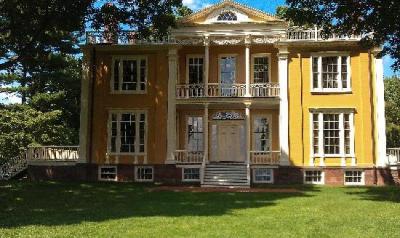Boscobel Cookbook
View Institution Homepage
Manuscript Cookbooks Survey Database ID#
1316Place of Origin
United States ➔ New York ➔ CortlandDate of Composition
1829-ca. 1870sDescription
The cookbook associated with Boscobel, a mansion located on the Hudson River about forty miles north of New York City, is entwined with the unusual marriages of two descendants of the original builders. The mansion was conceived by a wealthy gentleman farmer named States Morris Dyckman, who began construction in 1804. Sadly, he died 1806, leaving his wife Elizabeth to complete the house, where she lived with their son Peter until her death in 1823. Peter Dyckman died the following year and the house passed into the hands of his wife Susan Dyckman and their 19-month-old daughter Elizabeth, known as Eliza. In 1833, Susan married John Henry Cruger—and in 1837, at the age of 15, Eliza married John Henry Cruger’s younger brother, John Peach Cruger, then 25. Mother and daughter thus became sisters-in-law!
Comprising approximately 50 written pages, the cookbook is inscribed “Eliza Cruger Jany. 1829,” but this cannot be the Eliza Dyckman Cruger of Boscobel because she was only 7 years old in 1829 and neither she nor her mother had yet married into the Cruger family. The likely inscriber is Eliza Blair Cruger (1784-1868), who was a sister of John Harris Cruger, the father of the two Cruger brothers who would later marry Susan and Eliza. Eliza Blair Cruger probably wrote the first thirteen recipes in the book, which appear on pages 3 through 6. These pages seem to be in the same hand as the inscription. In addition, the cake recipes on these pages are consistent with the inscription date in that most are made without chemical leavening, as was typical in the 1820s though not later.
It is possible that Eliza Blair Cruger also wrote two clutches of recipes that appear later in the book, for the handwriting is similar. But it is more likely that three or four other individuals authored the rest of the book, probably between the 1850s and the 1870s, when the book’s recipes for Soda Cracker Pie, Cottage Pudding, Berwick Sponge Cake, Sponge Pudding, Snow Pudding, Bavarian Cream, Lyonnaise Potatoes, Saratoga Potatoes, and Potato Croquettes emerged. Also arguing for a mid-century date is the use of cream of tartar and soda as a leavening in a number of cake recipes and references to a “package of gelatin” in two recipes for wine jellies. The recipes for Lady Cake and Almond Cake on pages 29 to 30 of the book are copied verbatim from Eliza Leslie’s Directions for Cookery. This extremely popular book was first published in 1837 but was regularly republished in expanded editions into the 1850s.
So who wrote the later portions of the cookbook? Eliza Cruger would seem a likely author, though if she indeed found time to collect recipes, she must have been a whirlwind of energy. She bore fifteen children between 1838 and 1869, eight of whom survived into adulthood, and she published a 378-page book of poetry in 1868, Regina and Other Poems (which is currently available in several reprints). Other plausible authors are three unmarried adult children known to have been living in the household in 1880. Finally, Eliza's husband could have contributed to the book, and so could have her mother Susan. (She died in 1889, at age 89.)
Whoever the authors of this book were, they were primarily interested in recipes for puddings, pies, cakes, and tea breads. Recipes for the principal courses of the meal are found only in the hand that wrote from page 43 to the end of the book, where the three potato recipes mentioned above appear, as well as recipes for Tomato Toast, Ham Toast, Scrambled Eggs, Minced Veal and Eggs, and Mutton Cutlets. The book’s recipe for Bachelor Buttons, small nut-shaped crunchy cookies with almonds or currants, is unusual and was evidently a house favorite. It is written on page 41 of the book as well as on an inserted leaf.
Overall, the recipes seem incongruously modest and plain to have originated in so grand a house. Other than the Bavarian Cream and two of the potato recipes, there is no sign in the book of the fancy French cuisine that was typical in privileged households by the time of the Civil War. In fact, the Cruger household may not have had the means to keep up with the latest in French culinary fashions. According to one source, John Peach Cruger had run through most of his wife’s inheritance by the 1840s and was forced to lease the grounds of Boscobel for various commercial purposes. In 1857 the house was mortgaged to a relative, and in 1880 the mortgage was foreclosed. The new owners evidently allowed John Peach Cruger, by this point an invalid, to live on in the house until his death in 1888, at age 76. Eliza Cruger lived the last thirteen years of her life elsewhere, perhaps New York City. She died in 1901, at age 79.
The house fell to ruin during the twentieth century. Fortunately, in 1955, a determined group of preservation-minded individuals, backed by a large private grant, dismantled the house and reconstructed it on beautiful grounds overlooking the Hudson River in Garrison, New York, near its original site. Over the years the interior of Boscobel has been further restored to its glory days in the early nineteenth century. Today Boscobel is operated as a museum.

